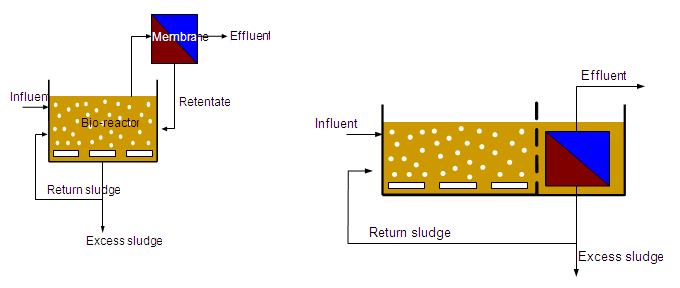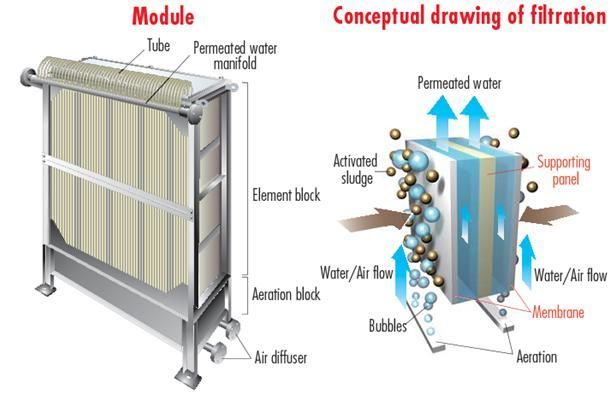How Membrane Bioreactor Can Improve the Quality of Wastewater Treatment
How Membrane Bioreactor Can Improve the Quality of Wastewater Treatment
Blog Article
The Advantages of Membrane Layer Bioreactors in Lasting Wastewater Monitoring
Membrane bioreactors (MBRs) represent a pivotal advancement in sustainable wastewater administration, properly merging biological treatment with innovative membrane purification modern technology. This integration not only enhances effluent quality by successfully getting rid of impurities however additionally opens opportunities for water reuse in numerous applications, therefore resolving journalism demand for resource conservation. The compact design of MBRs contributes to considerable reductions in ecological effect and functional expenses. As the need for sustainable services escalates, exploring the multifaceted benefits of MBRs might disclose unanticipated effects for the future of wastewater therapy systems.
Overview of Membrane Bioreactors
Membrane bioreactors (MBRs) represent a substantial advancement in wastewater therapy technology, incorporating organic destruction with membrane layer purification to boost the efficiency of the therapy procedure. This innovative system incorporates the advantages of conventional activated sludge procedures with membrane layer innovation, permitting improved solid-liquid separation. MBRs make use of semi-permeable membrane layers to different cured water from biomass, causing top quality effluent that can be reused or safely discharged into the setting.
The functional style of MBRs commonly involves a bioreactor where microbes break down raw material, complied with by a membrane system that filters the mixed alcohol. This configuration not only decreases the footprint of the treatment center yet likewise enables higher biomass focus and minimized hydraulic retention times. Furthermore, MBRs are qualified of dealing with a larger variety of contaminants, consisting of nutrients and virus, making them appropriate for various applications, from municipal wastewater therapy to commercial effluent handling.
The combination of MBRs right into wastewater administration systems is a measure of a growing pattern towards reliable and lasting methods in environmental engineering. Their ability to create premium effluent while lessening room demands settings MBR innovation as a key player in modern wastewater treatment services.
Enhanced Effluent Top Quality

The membrane layer purification procedure works as a physical obstacle, enabling the retention of microorganisms and particle matter, which adds to a more clear and cleaner effluent (Membrane Bioreactor). Furthermore, MBRs run at higher biomass concentrations than conventional activated sludge systems, advertising extra effective biodegradation of pollutants. This brings about a reduction in biochemical oxygen need (BODY) and total put on hold solids (TSS) levels in the final effluent
Furthermore, MBRs demonstrate exceptional performance in treating difficult wastewater make-ups, such as commercial effluents and wastewater with high nutrient lots. As a result, the effluent created is typically of better, enabling for even more adaptable disposal options and minimized environmental effect. Ultimately, the enhanced effluent quality attained via MBR innovation underscores its critical function in advancing lasting wastewater management practices.
Water Reuse Opportunities
The top quality effluent produced by membrane layer bioreactors (MBRs) opens substantial possibilities for water reuse in numerous applications. MBRs effectively get rid of pollutants, including microorganisms, put on hold solids, and raw material, causing cured water that fulfills or surpasses regulative criteria for reuse. This top quality enables the application of water recycling campaigns throughout diverse markets.
One popular application remains in farming, where dealt with wastewater can be used for irrigation, advertising lasting farming methods while preserving fresh water sources. Additionally, MBR-treated effluent can be utilized for industrial procedures such as cooling, cleansing, and as a process water resource, considerably check my blog reducing the need for potable water in these procedures.
In urban environments, MBRs assist in the use of redeemed water for landscape irrigation, commode flushing, and other non-potable uses, adding to the overall durability of water supply systems. The assimilation of MBR modern technology in decentralized systems aids in handling localized water demands, specifically in water-scarce areas.
Minimized Ecological Impact
Just how can find out here the fostering of membrane bioreactors (MBRs) add to a lowered environmental influence in wastewater management? MBRs dramatically boost the therapy effectiveness of wastewater while lessening environmental disruptions. Membrane Bioreactor.
Moreover, MBRs operate at lower hydraulic retention times contrasted to standard systems, resulting in smaller therapy plant footprints. This small style minimizes land use, therefore maintaining natural habitats and biodiversity. The process likewise creates much less sludge than traditional techniques, minimizing disposal challenges and reducing greenhouse gas emissions connected with sludge management.
In addition, MBRs promote the recuperation of important sources, such as water and nutrients, adding to a round economic situation. By enabling water reuse for irrigation or commercial procedures, MBRs help reduce freshwater deficiency, hence advertising sustainable water make use of techniques. Eventually, the fostering of MBR modern technology stands for a substantial stride towards lessening the environmental influence of wastewater management systems.
Economic Benefits of MBRs

Furthermore, MBRs help with the manufacturing of top notch effluent, which can be reused for different applications, such as agricultural irrigation and industrial procedures - Membrane Bioreactor. This reuse capacity can significantly reduce water procurement expenses, offering a monetary incentive for markets dealing with rigid water laws
The compact style of MBR systems additionally causes reduced land needs, which is especially beneficial in urban areas where realty is costly. By decreasing area, municipalities and markets can save money on land procurement and upkeep expenditures.
Moreover, MBRs frequently need much less constant upkeep and have a longer life expectancy than typical systems, additionally adding to set you back financial savings. In recap, the economic advantages of MBRs-- ranging from review minimized operational prices to land cost savings and effluent reuse-- make them an engaging choice for sustainable wastewater administration, providing both long-lasting and immediate economic advantages.
Conclusion
Membrane bioreactors represent a transformative technique to lasting wastewater monitoring, incorporating organic therapy with sophisticated membrane purification for superior effluent quality. Their capacity for effective pollutant elimination facilitates water reuse, thereby saving vital freshwater sources. Additionally, MBRs add to decreased environmental effects with compact styles and lower sludge generation. Economic benefits additionally improve their stability, making MBRs a promising service for resolving the challenges of wastewater therapy and advertising lasting source administration.
Membrane layer bioreactors (MBRs) represent a critical development in sustainable wastewater management, effectively merging biological treatment with advanced membrane filtration innovation.Membrane bioreactors (MBRs) stand for a considerable advancement in wastewater therapy modern technology, integrating organic degradation with membrane filtration to boost the effectiveness of the therapy procedure.Accomplishing enhanced effluent high quality is one of the most considerable advantages of utilizing membrane bioreactors (MBRs) in wastewater treatment.Furthermore, MBRs show exceptional performance in treating tough wastewater make-ups, such as commercial effluents and wastewater with high nutrient loads.Incorporating membrane bioreactors (MBRs) right into wastewater administration not only minimizes environmental impact however also presents considerable financial advantages.
Report this page